

This mechanism is designed to ensure the higher priority task is kept in the blocked state for the shortest time possible, and in so doing minimise the 'priority inversion' that has already occurred.” “If a high priority task blocks while attempting to obtain a mutex (token) that is currently held by a lower priority task, then the priority of the task holding the token is temporarily raised to that of the blocking task. The FreeRTOS documentation describes this as − The only difference is that Mutexes have priority inheritance. In practice, Mutex uses the same API functions as binary semaphores.
#Geting semaphor value serial#
If you have multiple resources (like OLED screen, SD Card, Serial port, etc.) that need to be protected, you can use multiple tokens, one for each resource. Other tasks have to wait till the token is released by that task. If a task has this token, only that task can access the particular resource. In order to avoid such a condition, we use a Mutex.

If multiple tasks access it simultaneously, there is a possibility of the corruption of the data within the SD Card (both may be writing to the same memory area, resulting in garbage). Say you have an SD Card that is being accessed by multiple tasks. MutexĪ mutex (Mutual Exclusion) is a locking mechanism that prevents corruption of shared resources. The count at any given point of time shows the difference between the number of events that have happened and the number of events processed. And every time a task processes the event, it indicates that it has ‘taken’ the semaphore by decrementing the count. Every time an event happens, an event handler ‘gives’ the semaphore by incrementing the count value. In this case, there are no restrictions on the length of the queue. This way, synchronization is achieved between tasks A and B. It will then set the value of the queue back to 0 (task B, thus, ‘takes’ the semaphore), and wait again for data to be available.

Task B, which is continuously monitoring the semaphore, will read the data when the value is 1. When data is available, it sets the semaphore value to 1 (task A ‘gives’ the semaphore here). If task A needs to send some periodic communication to task B (say exchange of data), then it uses this binary semaphore to communicate. Say there are two tasks: task A and task B. It can take only 0 and 1 as the integer values. There are two types of semaphores: Binary Semaphore and Counting Semaphore. In practice, this is maintained by integers. Once the task has done that work, it will give the semaphore back. A task in the waiting state may receive a semaphore which tells it to do some work. More specifically, it is a signalling mechanism. SemaphoreĪ semaphore is a synchronization mechanism between tasks. In this article, we will look at the concepts of semaphore and mutex. Often, two tasks need to share a resource, or one task needs to tell another that it is idle/waiting.

Semaphore and Mutex are tools/mechanisms to bring about synchronization between tasks in FreeRTOS.


 0 kommentar(er)
0 kommentar(er)
